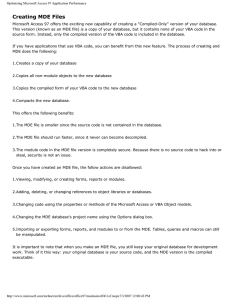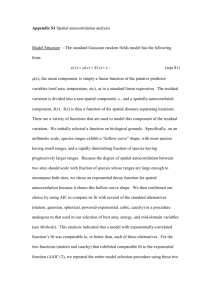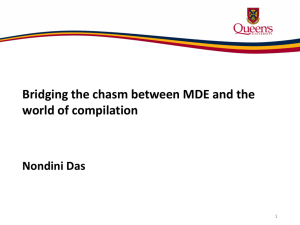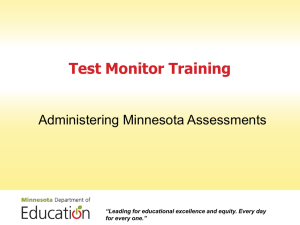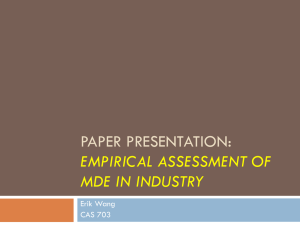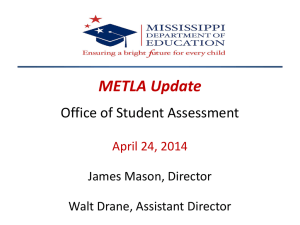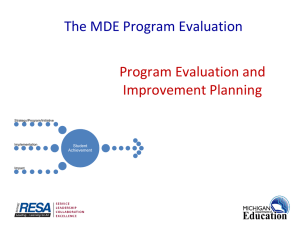Teacher Evaluation and Pay for Performance
advertisement
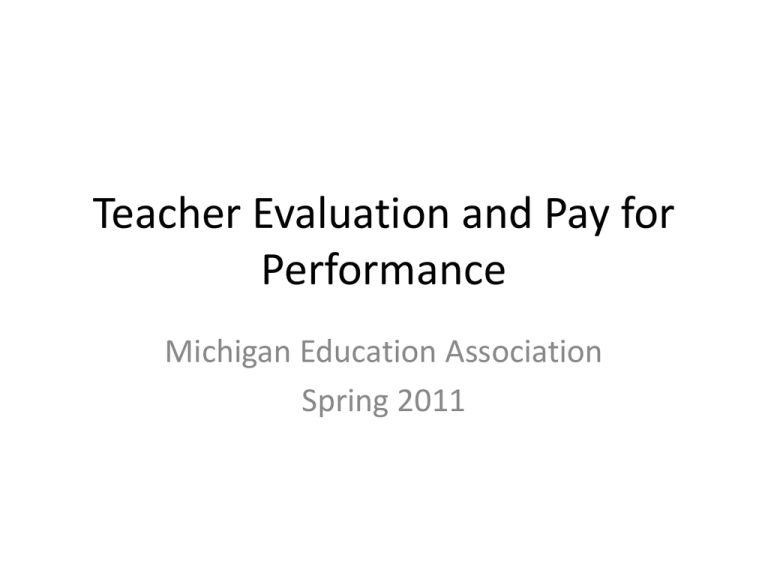
Teacher Evaluation and Pay for Performance Michigan Education Association Spring 2011 Teacher Evaluation and Pay for Performance • The Michigan Revised School Code closely links teacher evaluation (380.1249)and pay for performance (380.1250) together. Pay for performance depends, in part, on a teacher’s evaluation which must be tied to student growth. The link to student growth has created the greatest challenge to local implementation. Teacher Evaluation and Pay for Performance • How has teacher evaluation changed: – Teachers and school administrators must be evaluated annually (*note that the language states evaluated not observed) – The evaluation process must have multiple rating categories – The evaluation must provide timely and constructive feedback, and multiple opportunities for improvement Teacher Evaluation and Pay for Performance • How has teacher evaluation changed: – Student growth must be considered as a “significant factor” (*note that MDE now takes the position that this must be defined locally through the collective bargaining process) in the evaluation and determined using national, state, and local assessments , or other objective criteria. The language of the law provides a good deal of flexibility to implementation. Teacher Evaluation and Pay for Performance • How is the new teacher evaluation process to be used by the districts? – The law states that evaluations should be used to help make decisions about--• The retention and promotion of teachers • In recommending tenure and advanced certification • Helping teachers improve in their teaching practices, particularly when there are deficiencies by proving ample opportunity to improve • To provide for pay for performance Teacher Evaluation and Pay for Performance • How does the MEA suggest a local association implement the student growth requirement? – While it is the decision of the local association and district on how to define student growth, the MEA suggests that the greatest weight should be placed on local assessments, such as end-ofcourse tests, pre and post testing, teacher developed tests, student artifacts (projects, portfolios, etc.). State assessments, such as the MEAP or ACT/MME, are better suited to a whole school application rather than individual teachers. Teacher Evaluation and Pay for Performance • How much weight should student growth be given in the overall evaluation process? – The Michigan Department of Education (MDE) has taken the position that the definition of student growth is a local decision reached through the collective bargaining process. The MDE recognizes that it has no authority in law to determine what “significant factor” means and, therefore, will not offer any further guidance. Teacher Evaluation and Pay for Performance • Is there a reasonable approach to defining student growth? – The MEA suggests the following distribution of weight be given to the components of student growth: • State Assessments no more than 15 % • Locally selected standardized tests no more than 35% • Locally developed assessments about 50% – This may include student achievement case studies Teacher Evaluation and Pay for Performance • What percentage of the overall teacher evaluation should be attributed to student growth? – The MEA suggests that 20-25% of the overall weight of a teacher’s evaluation should be determined from student growth. The remaining 75-80% of weight should be determined from the locally agreed upon evaluation method which may include an observation of the teacher’s performance. Teacher Evaluation and Pay for Performance • How will the MDE link student achievement to a teacher? – Beginning this fall the MDE will return to districts reports which link student achievement on state assessments to any teacher the student had throughout the year. This means at the high school level all 6 or 7 of a student’s teachers will receive a report on how the student performed on the ACT/MME. Teacher Evaluation and Pay for Performance • How will the MDE reports impact middle school and elementary teachers? – Middle school and elementary teachers will be linked to the performance of the previous year’s students on the current MEAP test. For instance a third grade teacher will receive a report on how the previous year’s third graders assigned to that classroom performed on this year’s test. Teacher Evaluation and Pay for Performance • How will the linkage between the teacher and the student be made? – At the end of this academic year each district will report to the MDE the link between the teacher and the student by providing the student’s schedule. It is very important that teachers have an opportunity to verify the list before it is sent to MDE to avoid discrepancies in the returned report. Errors can and will be made. Teacher Evaluation and Pay for Performance • How will the performance status of each student be reported by MDE? – The MDE will not be reporting a numerical value for each student’s performance on the state assessment, rather one of the following status indicators will be reported for each test taken: • • • • • Significant increase Increase Maintaining Decline Significant decline Teacher Evaluation and Pay for Performance • Does the MDE suggest how the reported data may be used at the district level? – The MDE has taken the position that it is only obligated to report the information back to the district. How the information is used, if at all, at the district level is a local decision. The manner in which the data is reported back will make it difficult to determine use at the individual teacher level but may be useful in the aggregation at the whole school level. Teacher Evaluation and Pay for Performance • What considerations should be taken when determining the use of state reports at the school level? – As with any set of data on student achievement some consideration must be given to students who should be excluded from the final weight placed on student growth. For instance, students who were not enrolled in the school for a full year, students with poor attendance records, students who have had extensive periods of suspension, or who have been expelled, etc. These exclusionary considerations should be the subject of bargaining. Teacher Evaluation and Pay for Performance • Are the reports sent to the district able to be accessed by the public? – There is no absolute answer to whether the reports will be available through a FOIA request. However, the MDE plans to take steps to lessen the availability of the reports to the public by including the names of the students linked to each teacher in the report and protect the information under FERPA. Each report will also be considered a draft report not assured of complete accuracy which may prevent a successful FOIA request. Teacher Evaluation and Pay for Performance • Are there other reporting requirements regarding teacher evaluation? – Beginning in Spring 2012 each district must report to the MDE the evaluation status of all teachers employed by the district. Each teacher must be rated as highly effective, effective, or ineffective as required by federal legislation (the State Fiscal Stabilization Fund Act of 2009). Districts which use other multiple rating categories must align the district terms to the state’s terms. Teacher Evaluation and Pay for Performance • Will this information be released to the public? – The MDE must send a report to the federal government identifying the percent of teachers in each category. The MDE report will be an aggregation of the data sent in by districts and will have no names attached. However, the information sent to the MDE from the districts will name teachers and could be subject to a FOIA request at the local level. Teacher Evaluation and Pay for Performance • Has the MEA developed a model for teacher evaluation? – The MEA, AFT-Michigan, MASSP, and MEMSPA collaborated together to develop a guide to implementing the new teacher evaluation process. The document is known as the “Framework for Educator Evaluation” (FEE) which has been endorsed by the Michigan Department of Education. It is a collaborative approach to evaluation between the building administrator and the teacher. Teacher Evaluation and Pay for Performance • How does collaboration occur in the FEE model? – The model relies on identified school improvement goals at the district level and building level as well as some organization of staff into professional learning communities, grade level committees, or departmental committees. Every teacher is expected to be a member of a committee and develop improvement goals for the team and from there develop individual goals. The building administrator and teacher agree on an individual professional growth plan where the goals are implemented. Teacher Evaluation and Pay for Performance • Remember to strive to develop an evaluation plan that is –Rational and Defensible Teacher Evaluation and Pay for Performance • What does the law require relative to teacher compensation? – Section 1250 (1)(MRSC) “…The assessment of job performance shall incorporate a rigorous, transparent , and fair evaluation system that evaluates a teacher’s or school administrator’s performance at least in part based upon data on student growth as measured by assessments and other objective criteria.” Hence the link between evaluation and pay for performance.

